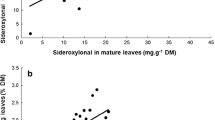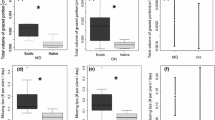Abstract
Plant secondary metabolites (PSMs) offer plants chemical defences against herbivores, and are known to influence intake and diet choice in both insect and mammalian herbivores. However, there is limited knowledge regarding how PSMs influence herbivore foraging decisions. Herbivore foraging decisions, in turn, directly impact on which individual plants, and plant species, are selected for consumption. We took advantage of the natural variation in sideroxylonal concentrations in the foliage of Eucalyptus melliodora (Cunn. ex Schauer) to investigate feeding patterns of a marsupial folivore, the common ringtail possum, Pseudocheirus peregrinus (Boddaert 1785). Foliage, collected from six trees, contained between 0.32 and 12.97 mg g-DM-1 sideroxylonal. With increasing sideroxylonal concentrations, possums decreased their total intake, rate of intake and intake per feeding bout, and increased their cumulative time spent feeding. Possums did not alter their total feeding time, number of feeding bouts or time per feeding bout in response to increasing sideroxylonal concentrations. Results demonstrate important behavioural changes in foraging patterns in response to sideroxylonal. These behavioural changes have important implications, in relation to altered foraging efficiency and potential predation risk, for herbivores foraging in the field. As a result, the spatial distribution of dietary PSMs across a landscape may directly influence herbivore fitness, and ultimately habitat selection of mammalian herbivores.






Similar content being viewed by others
References
Bernays EA, Bright KL, Gonzalez N, Angel J (1994) Dietary mixing in a generalist herbivore: tests of two hypotheses. Ecology 75:1997–2006
Boyle RR, McLean S (2004) Constraint of feeding by chronic ingestion of 1,8-cineole in the brushtail possum (Trichosurus vulpecula). J Chem Ecol 30:757–775
Dearing DM, Cork S (1999) Role of detoxification of plant secondary compounds on diet breadth in a mammalian herbivore, Trichosurus vulpecula. J Chem Ecol 25:1205–1219
Eschler BM, Pass DM, Willis IR, Foley WJ (2000) Distribution of foliar formylated phloroglucinol derivatives amongst Eucalyptus species. Biochem Syst Ecol 28:813–824
Feeny P (1970) Seasonal changes in oak leaf tannins and nutrients as a cause of spring feeding by winter moth caterpillars. Ecology 51:565–581
Foley WJ (1992) Nitrogen and energy retention and acid–base status in the common ringtail possum (Pseudocheirus peregrinus): evidence of the effects of absorbed allelochemicals. Physiol Zool 65:403–421
Foley WJ, Iason GR, McArthur C (1999) Role of plant secondary metabolites in the nutritional ecology of mammalian herbivores: how far have we come in 25 years? In: Jung HG, Fahey GC (eds) Nutritional ecology of herbivores. American Society of Animal Science, Illinois, pp 130–209
Foley WJ, Lawler IR, Moore BD, Marsh KJ, Wallis IR (2004) Diet selection in marsupial folivores of Eucalyptus: the role of plant secondary metabolites. In: Goldingay RL, Jackson SM (eds) Possums and gliders. Surrey Beatty and Sons, Chipping Norton, pp 207–221
Fraenkel GS (1959) The raison d’être of secondary plant substances. Science 129:1466–1470
Freeland WJ, Janzen DH (1974) Strategies in herbivory by mammals: the role of plant secondary compounds. Am Nat 108:269–289
Graham HD (1992) Stabilization of the Prussian blue color in the determination of polyphenols. J Agric Food Chem 40:801–805
Hagerman AE (1995) Tannin analysis, 2nd edn. Miami University, Oxford
Hillis WE (1966) Variation in polyphenol composition within species of Eucalyptus L’Herit. Phytochemistry 5:541–556
Lawler IR, Foley WJ, Eschler BM, Pass DM, Handasyde K (1998a) Intraspecific variation in Eucalyptus secondary metabolites determines food intake by folivorous marsupials. Oecologia 116:160–169
Lawler IR, Foley WJ, Pass GJ, Eschler BM (1998b) Administration of a 5HT3 receptor antagonist increases the intake of diets containing Eucalyptus secondary metabolites by marsupials. J Comp Physiol B 168:611–618
Lawler IR, Foley WJ, Eschler BM (2000) Foliar concentration of a single toxin creates habitat patchiness for a marsupial folivore. Ecology 81:1327–1338
Li H, Madden JL, Potts BM (1995) Variation in volatile leaf oils of the Tasmanian Eucalyptus species I Subgenus Monocalyptus. Biochem Syst Ecol 23:299–318
Li H, Madden JL, Potts BM (1996) Variation in volatile leaf oils of the Tasmanian Eucalyptus species II Subgenus Symphyomyrtus. Biochem Syst Ecol 24:547–569
Lowther JR (1980) Use of a single sulphuric acid–hydrogen peroxide digest for the analysis of Pinus radiata needles. Commun Soil Sci Plant Anal 11:175–188
McArthur C, Robbins CT, Hagerman AE, Hanley TA (1993) Diet selection by a ruminant generalist browser in relation to plant chemistry. Can J Zool 71:2236–2243
Meyer MW, Karasov WH (1989) Antiherbivore chemistry of Larrea Tridentata: effects on woodrat (Neotoma lepida) feeding and nutrition. Ecology 70:953–961
O’Reilly-Wapstra JM, McArthur C, Potts BM (2004) Linking plant genotype, plant defensive chemistry and mammal browsing in a Eucalyptus species. Funct Ecol 18:677–684
Pass GJ, Foley WJ (2000) Plant secondary metabolites as mammalian feeding deterrents: separating the effects of the taste of salicin from its post-ingestive consequences in the common brushtail possum (Trichosurus vulpecula). J Comp Physiol B 170:185–192
Pfister JA, Provenza FD, Manners GD, Gardner DR, Ralphs MH (1997) Tall larkspur ingestion: can cattle regulate intake below toxic levels? J Chem Ecol 23:759–777
Provenza FD (1995) Postingestive feedback as an elementary determinant of food preference and intake in ruminants. J Range Manage 48:2–17
Provenza FD, Pfister JA, Cheney CD (1992) Mechanisms of learning in diet selection with reference to phytotoxicosis in herbivores. J Range Manage 45:36–45
Ratkowsky DA, Evans MA, Alldredge JR (1993) Cross-over experiments: design, analysis, and application. Marcel Dekker, New York
Robbins CT, Hanley TA, Hagerman AE, Hjeljord O, Baker DL, Schwartz CC, Mautz WW (1987) Role of tannins in defending plants against ruminants: reduction in protein availability. Ecology 68:98–107
SAS Institute Inc. (1990) SAS procedures guide, 3rd edn. SAS Institute Inc., Cary
Singer MS, Bernays EA, Carrière Y (2002) The interplay between nutrient balancing and toxin dilution in foraging by a generalist insect herbivore. Anim Behav 64:629–643
Stapley J, Foley WJ, Cunningham R, Eschler B (2000) How well can common brushtail possums regulate their intake of Eucalyptus toxins? J Comp Physiol B 170:211–218
Wallis IR, Foley WJ (2002) Independent variation of near-infrared reflectance spectroscopy as an estimator of potential food intake of Eucalyptus polyanthemos foliage for common ringtail possums (Pseudocheirus peregrinus). Aust J Zool 51:95–98
Wallis IR, Watson ML, Foley WJ (2002) Secondary metabolites in Eucalyptus melliodora: field distribution and laboratory feeding choices by a generalist herbivore, the common brushtail possum. Aust J Zool 50:507–519
Wallis IR, Herlt AJ, Eschler BM, Takasaki M, Foley WJ (2003) Quantification of sideroxylonals in Eucalyptus foliage by high-performance liquid chromatography. Phytochem Anal 14:360–365
Wiggins NL, McArthur C, McLean S, Boyle R (2003) Effects of two plant secondary metabolites, cineole and gallic acid, on nightly feeding patterns of the common brushtail possum. J Chem Ecol 29:1423–1440
Acknowledgements
The authors thank Rose Andrews for help with foliage collection. Research was approved by University of Tasmania and Australian National University Animal Ethics Committees (Ethics Permit Numbers A6700 and F.BTZ.44.02). Research was funded by an Australian Postgraduate Award and the CRC for Sustainable Production Forestry.
Author information
Authors and Affiliations
Corresponding author
Additional information
Communicated by Roland Brandl
Rights and permissions
About this article
Cite this article
Wiggins, N.L., Marsh, K.J., Wallis, I.R. et al. Sideroxylonal in Eucalyptus foliage influences foraging behaviour of an arboreal folivore. Oecologia 147, 272–279 (2006). https://doi.org/10.1007/s00442-005-0268-0
Received:
Accepted:
Published:
Issue Date:
DOI: https://doi.org/10.1007/s00442-005-0268-0




